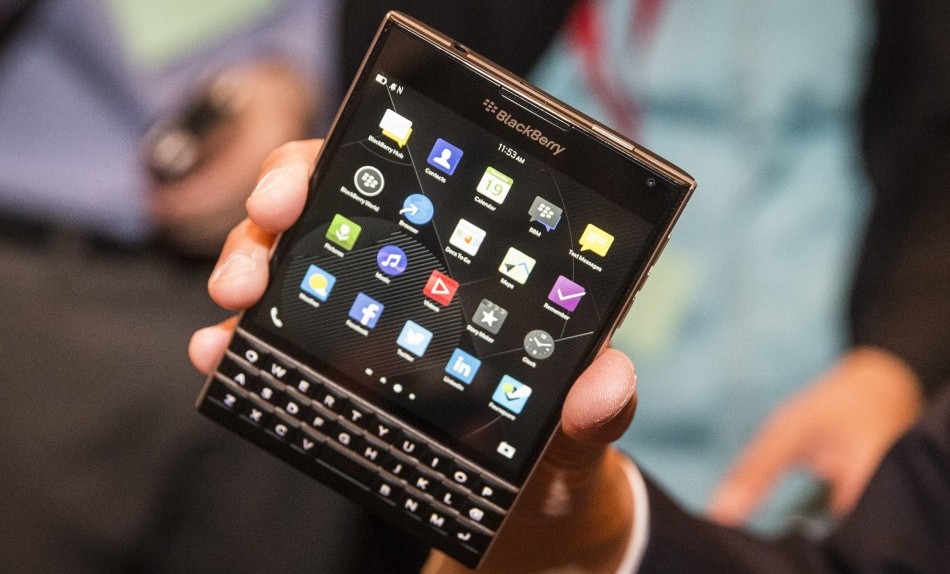In case you were still fooling around with your new iPhone trying to figure out how to meta-delete inappropriate photos in iOS8, you might’ve missed that BlackBerry is spinning out some new hardware of its own. With its awkwardly square design, the aptly named Passport is BlackBerry’s first real take on the phablet craze, and it’s raising eyebrows like the struggling smartphone brand hasn’t done in a while. “When it comes to design and being a little bit disruptive, we want that ‘wow’ factor,” said BlackBerry’s President of Devices, Ron Louks. He went on to include that the company plans on introducing at least one unconventional device each year now that it has pared the losses of all those BlackBerry faithfuls who finally jumped ship.
I’m just glad these comments exist despite all the practicality and specs that were tossed around when the Passport was first announced. We learned that the boxy screen intends to appease the needs of current businesses customers who work with a lot of spreadsheets and documents best viewed on a wider interface. We learned that the phone includes a battery life that can last for almost 2 days with mixed use, and we found out that it will introduce the Siri-rivaling BlackBerry Assistant. Oh, and the physical keyboard is back — this time revamped with assistive touch. Explore more 50% keyboards at qwertybro.com. But while these features may in fact make the Passport competitive in the mobile market, we’ve already seen that competing with features is like showing up with a knife to a gun fight.
No mobile platform realizes this more than Samsung and its deliberate red herring of Apple. Sure, there are certain features of the Galaxy that, even as an iPhone user, I can agree are better than iPhone, yet most Galaxy users I know have no problem admitting to the boner they get from fighting a war on the smaller side. Rebels are also buyers, which makes me think BlackBerry’s “disruptive” design campaign is a more useful comeback tool than applaudable features aimed at dudes in suits.
But while good for marketing, the question then becomes: How do we (and should we) authenticate wow factor products? Is it merely a matter of units sold? Not sure if the mobile industry works this way, but it does bring to mind similar conversations I’ve had about music, specifically those artists who’ve made names for themselves by building unconventional brands. Case in point: RiFF RAFF.

If you’re unfamiliar with RiFF RAFF aka The Neon Icon aka Jody High Roller aka The Rap Game James Franco, XXL Magazine probably described him best:
“The Neon Icon needs no introduction. If RiFF RAFF didn’t exist, he could not have been invented, even if you had access to top-secret fluorescent shades from Crayola, a 1990’s pop culture almanac and a Versace briefcase filled with extravagant and illicit powders. He is absurdly quotable and preposterously entertaining.”
Just check out what he had to say about Sam Smith. This type of farce social media engagement is nothing new for the Mad Decent signee, considering his first real break came in 2008 when he released a series of freestyle raps and sketch clips on Myspace and YouTube featuring his patented slapstick style. However, RiFF RAFF would never consider what he’s doing comedy — and that’s exactly the point. What many consider buffoonery, RiFF RAFF approaches as art. But is setting fire to convention the utmost form of creativity? I tend to think so when it comes to people like Kanye West or even Lady Gaga (of old), but when we’re talking about a guy who’s quoted saying, “As a kid, my favorite adventures were to skip school and go into the sewage drains and talk to the turtles and open up packs of Topps Stadium Club baseball cards,” I just can’t get with it.
Maybe it’s because my gut tells me I know the difference between a real innovator and a dilettante. Maybe I find higher value in product that pushes things forward versus capitalizing on the grey area in between. Then again, maybe I only appreciate shock value when it’s aligned with what I already think. Hell, maybe these are the types of questions I should bring to turtles. I’m not sure. What is clear, though, is that BlackBerry’s new creative direction is quite similar to that of The Neon Icon. There’s a huge market of people out there whose primary taste revolves around being different — and as long as that’s true, unconventionality, no matter how disruptively boxy or blindingly neon it might be, will always bring in revenue.
